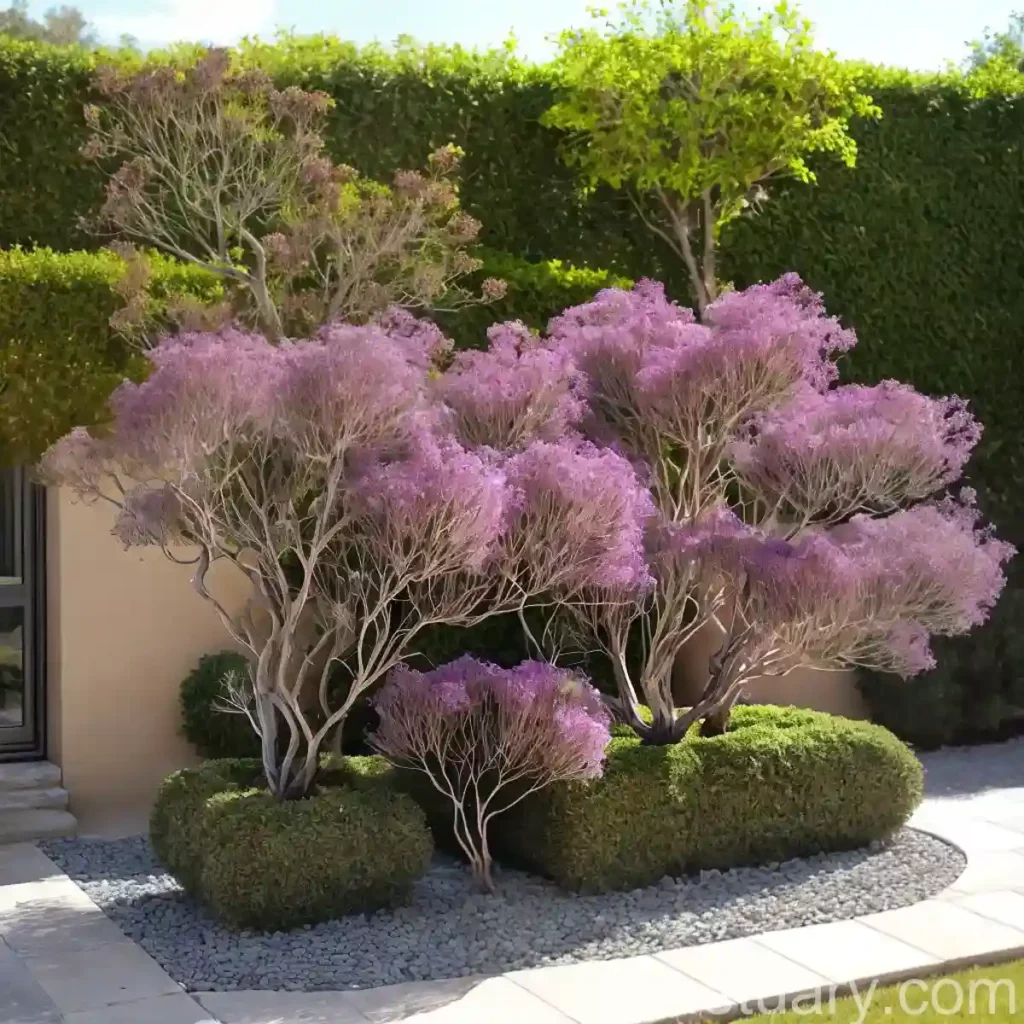Plant Scientist’s Guide to Smoketree (Cotinus coggygria ‘Kolcot’ GREEN FOUNTAIN)
Introduction
Plants are essential elements of our environment, providing us with oxygen, food, and medicine. They also contribute to the aesthetics of our surroundings, adding beauty and diversity. In this extensive guide, we will delve into the fascinating world of the ‘Green Fountain’ smoketree (Cotinus coggygria ‘Kolcot’), exploring its characteristics, growing requirements, uses, and much more.
What is the Smoketree (Cotinus coggygria ‘Kolcot’ GREEN FOUNTAIN)?
The ‘Green Fountain’ smoketree (Cotinus coggygria ‘Kolcot’), also known as smoke tree, is a deciduous shrub that belongs to the Anacardiaceae family. This unique plant is characterized by its stunning green foliage and ethereal plume-like inflorescences that resemble puffs of smoke, giving it the name “smoketree.” The ‘Green Fountain’ cultivar is especially renowned for its vibrant, lime-green leaves and graceful, cascading growth habit, making it an exceptional ornamental addition to gardens and landscapes.
Key Takeaways – ‘Green Fountain’ Smoketree (Cotinus coggygria ‘Kolcot’)
Before we delve into the comprehensive care and cultivation guide for the ‘Green Fountain’ smoketree, let’s take a quick overview of the key takeaways:
- Plant Name: ‘Green Fountain’ smoketree (Cotinus coggygria ‘Kolcot’)
- Family: Anacardiaceae
- Common Names: Smoke tree, Green Fountain smoketree
- Characteristics: Vibrant lime-green foliage, cascading growth habit, ethereal smoke-like inflorescences
- Growing Requirements: Water, sunlight, fertilizer, soil, pruning, propagation, container considerations
- Uses: Ornamental landscaping, focal point plantings, wildlife gardens
- Common Diseases: Anthracnose, powdery mildew
- Common Pests: Aphids, caterpillars, scale insects
- Botanist’s Tips: Mitigating disease susceptibility, shaping for aesthetic appeal, wildlife-friendly plantings
- Fun Facts: Unique autumn colors, drought-tolerant, deer-resistant
Now that we have an overview of the ‘Green Fountain’ smoketree, let’s delve deeper into its culture, growing requirements, and various aspects of its care and maintenance.
Culture
The successful cultivation of ‘Green Fountain’ smoketree (Cotinus coggygria ‘Kolcot’) relies on understanding its specific cultural requirements. From water and sunlight to soil preferences and pruning techniques, each aspect plays a crucial role in nurturing this stunning ornamental plant.
Water
Proper watering is essential for the health and vigor of ‘Green Fountain’ smoketree. While it exhibits some tolerance to dry conditions once established, regular watering is pivotal, especially during periods of drought. Adequate moisture levels promote lush foliage and support the development of the plant’s characteristic smoky inflorescences.
- Water Requirements: Moderate to regular watering
- Establishment Phase: Keep the soil consistently moist
- Mature Plants: Allow the soil to dry slightly between waterings
- Drought-Tolerance: Exhibits some tolerance to dry conditions once established
- Watering Practices: Water deeply to encourage deep root growth
Sunlight
Sunlight is a primary factor influencing the growth, foliage color, and flowering of ‘Green Fountain’ smoketree. Adequate exposure to sunlight is essential for promoting the plant’s vibrant lime-green foliage and ensuring profuse blooming of its characteristic smoke-like inflorescences.
- Sunlight Requirements: Full sun to partial shade
- Foliage Color: Best foliage coloration is achieved in full sun
- Flowering: Profuse blooming is promoted by adequate sunlight
- Shade Tolerance: Exhibits some tolerance to partial shade
Fertilizer
Proper fertilization contributes to the overall health and vitality of ‘Green Fountain’ smoketree. Choosing the right type of fertilizer and timing of application can significantly impact the foliage color, flowering, and overall growth of this ornamental shrub.
- Fertilizer Type: Balanced, slow-release fertilizer
- Application Timing: Apply in early spring before new growth begins
- Fertilization Frequency: Yearly application is usually sufficient
- Pruning: Light fertilization after pruning can support new growth
Soil
Understanding the soil preferences of ‘Green Fountain’ smoketree is essential for creating an optimal growing environment. Well-drained, fertile soil with moderate to slightly acidic pH levels provides an ideal foundation for the plant’s growth and development.
- Soil Type: Well-drained, fertile soil
- pH Preference: Slightly acidic to neutral (pH 5.5-7.0)
- Soil Amendments: Organic matter and mulch can improve soil quality
- Container Planting: Use well-draining potting mix for container-grown specimens
Pruning
Pruning plays an essential role in shaping the growth habit, maintaining the plant’s health, and promoting abundant flowering of ‘Green Fountain’ smoketree. Understanding the best pruning practices for this ornamental shrub is key to achieving an aesthetically pleasing form and ensuring its long-term well-being.
Pruning Timing
Understanding the optimal timing for pruning ‘Green Fountain’ smoketree is crucial for minimizing stress, promoting vigorous growth, and preserving the plant’s ornamental attributes.
- Best Timing: Late winter to early spring before new growth emerges
- Avoid Late Pruning: Late pruning can reduce flowering and impact new growth
- Dead/Damaged Wood: Can be pruned out at any time during the year
Pruning Techniques
Applying the correct pruning techniques can help shape the plant, remove diseased or damaged branches, and encourage the development of new growth and prolific flowering in ‘Green Fountain’ smoketree.
- Thinning: Remove overcrowded or crossing branches to improve air circulation
- Shaping: Prune for an open, natural form or a more structured appearance
- Heading Back: Trim long shoots to maintain the desired size and shape
- Deadheading: Remove spent flower clusters to encourage additional blooming
Propagation
Propagation allows for the expansion of ‘Green Fountain’ smoketree populations and the preservation of unique cultivars. Understanding the various propagation methods and the best timing for propagation is essential for successfully propagating this ornamental shrub.
Propagation Methods
- Softwood Cuttings: Best performed in early summer when new growth is still soft
- Hardwood Cuttings: Late autumn or early winter cuttings can be overwintered for planting in spring
- Semi-Hardwood Cuttings: Late summer to early autumn is suitable for semi-ripe wood cuttings
- Air Layering: Encourages roots to form on a stem while still attached to the parent plant
Container Popularity
The ‘Green Fountain’ smoketree (Cotinus coggygria ‘Kolcot’) is well-suited for container cultivation, making it a favored choice for adding ornamental interest to patios, balconies, and small outdoor spaces. When growing ‘Green Fountain’ smoketree in containers, certain considerations and care practices are essential for ensuring its health and vitality.
Container Considerations
Proper selection of containers, soil mix, and maintenance practices can significantly influence the growth and performance of ‘Green Fountain’ smoketree in a containerized environment.
- Container Size: Choose a spacious container to accommodate the plant’s mature size
- Drainage: Ensure proper drainage to prevent waterlogging
- Soil Mix: Use well-draining potting mix enriched with organic matter
- Watering: Regular monitoring and watering are crucial in container cultivation
- Fertilization: Light, regular fertilization supports the plant’s growth in containers
Common Diseases
Despite being a relatively low-maintenance and hardy plant, ‘Green Fountain’ smoketree (Cotinus coggygria ‘Kolcot’) is susceptible to certain diseases that can impact its overall health and ornamental appeal. Understanding the common diseases and their management is essential for preserving the vitality of this stunning shrub.
Disease Diagnosis
Early detection and appropriate management strategies are essential for preventing the spread and impact of diseases on ‘Green Fountain’ smoketree.
Anthracnose
Anthracnose is a fungal disease that can affect the foliage and branches of ‘Green Fountain’ smoketree, causing spotting, wilting, and defoliation under severe infestations.
- Symptoms: Small, dark spots on leaves, wilting, and dieback of branches
- Management: Prune affected parts, promoting good air circulation, and applying fungicidal sprays
Powdery Mildew
Powdery mildew is a common fungal disease that can affect the foliage of ‘Green Fountain’ smoketree, leading to powdery white growth and distortion of leaves.
- Symptoms: White, powdery coating on leaves, leaf distortion
- Management: Improving air circulation, avoiding overhead watering, and applying fungicidal sprays
Common Pests
In addition to diseases, ‘Green Fountain’ smoketree (Cotinus coggygria ‘Kolcot’) can attract certain pests that may impact its overall health and vitality. Identifying and managing these common pests is crucial for preserving the ornamental appeal and vigor of this stunning shrub.
Aphids
Aphids are small, soft-bodied insects that can infest the foliage of ‘Green Fountain’ smoketree, causing leaf curling, yellowing, and honeydew production.
- Identification: Small, pear-shaped insects on the undersides of leaves
- Management: Spraying with insecticidal soap or horticultural oil, encouraging natural predators
Caterpillars
Caterpillars, the larval stage of moths and butterflies, can feed on the foliage of ‘Green Fountain’ smoketree, leading to defoliation and aesthetic damage.
- Identification: Presence of caterpillars on foliage, feeding damage
- Management: Handpicking, biological control using predatory insects, or targeted insecticides
Scale Insects
Scale insects can infest ‘Green Fountain’ smoketree, attaching themselves to stems and leaves and feeding on plant sap, leading to stunted growth and yellowing of foliage.
- Identification: Small, immobile, scale-like insects on stems and leaves
- Management: Pruning infested parts, applying horticultural oil, encouraging natural predators
Understanding the signs of pest infestation and implementing appropriate management strategies is essential for maintaining the health and vigor of ‘Green Fountain’ smoketree.
Botanist’s Tips
As a plant scientist, I would like to provide some additional tips and insights for optimizing the care, health, and ornamental potential of ‘Green Fountain’ smoketree. Here are some key recommendations for cultivating and managing this stunning shrub:
Disease Resistance
When selecting ‘Green Fountain’ smoketree for your garden or landscape, consider cultivars or varieties with enhanced disease resistance. Disease-resistant selections can offer added peace of mind and reduced maintenance requirements.
Shaping and Pruning
Pruning ‘Green Fountain’ smoketree for shape and aesthetics is a rewarding practice. Consider different pruning styles, such as naturalistic shaping or formal training, to accentuate the unique growth habit and foliage of this ornamental shrub.
Wildlife-Friendly Plantings
Incorporating ‘Green Fountain’ smoketree into wildlife-friendly plantings can support local biodiversity and attract beneficial insects, birds, and other wildlife to your garden. The ethereal inflorescences and vibrant foliage of this shrub can contribute to a visually stunning and ecologically vibrant landscape.
Fun Facts
To conclude our comprehensive guide to ‘Green Fountain’ smoketree, here are some fascinating fun facts about this unique and captivating plant:
- Drought-Tolerant: ‘Green Fountain’ smoketree exhibits remarkable tolerance to dry conditions once established, making it a reliable choice for water-wise landscapes.
- Deer-Resistant: The aromatic foliage and ethereal inflorescences of ‘Green Fountain’ smoketree are less appealing to browsing deer, making it a suitable choice for deer-prone areas.
- Autumn Colors: In the fall, ‘Green Fountain’ smoketree showcases a stunning display of autumn colors, ranging from fiery oranges and reds to rich purples and deep burgundies, adding a dramatic touch to the landscape.
Links to External Resources
For additional information on ‘Green Fountain’ smoketree (Cotinus coggygria ‘Kolcot’) and related topics, I recommend exploring the following resources:
- Cotinus coggygria ‘Kolcot’ – Missouri Botanical Garden
- Landscaping with Smoke Trees – University of Florida IFAS Extension
- Growing Ornamental Plants in the Landscape – Penn State Extension
In conclusion, the ‘Green Fountain’ smoketree (Cotinus coggygria ‘Kolcot’) is a truly exceptional ornamental shrub that offers a unique combination of vibrant foliage, ethereal plume-like inflorescences, and low-maintenance appeal. By understanding its cultural requirements, diseases, and pests, along with implementing botanist’s tips and fun facts, you can cultivate and enjoy this captivating plant to its fullest potential.
Whether used as a focal point in the landscape, a container specimen, or as part of wildlife-friendly plantings, ‘Green Fountain’ smoketree lends an enchanting and distinctive charm to any outdoor setting.
I hope this comprehensive guide has provided valuable insights and inspiration for incorporating and caring for ‘Green Fountain’ smoketree in various garden and landscape settings.
Happy gardening!















